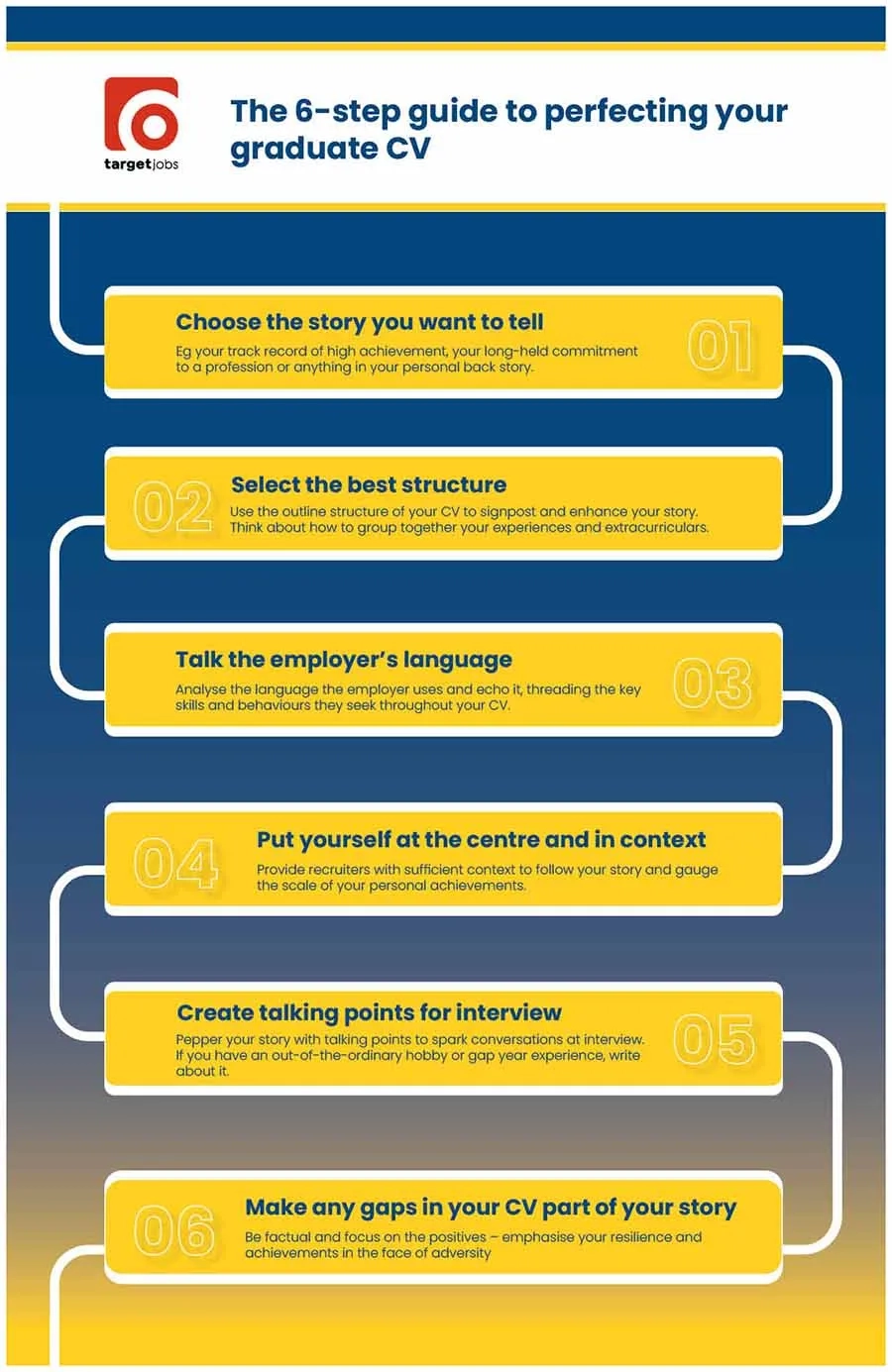Applications
The 6-step guide to perfecting your graduate CV
1 Aug 2024, 08:10
Find out how to make your CV tell a story with the help of our advanced CV writing masterclass. Polish your CV and convince graduate employers you are perfect for the job.

Want to stand out from the job-hunting competition? Use your CV to construct a narrative about yourself. By which we mean that you should select an ‘image’ of yourself (or persona) that you want to promote and then use every sentence on your CV to create it. The CV gurus who advise experienced hire candidates call this CV storytelling.
Follow our six steps to help you perfect your narrative and your graduate CV:
- Choose the story you want to tell
- Select the best structure
- Talk the employer’s language
- Put yourself at the centre and in context
- Create talking points
- Make any gaps part of your story
These CV-enhancing top performance tips will help you to move beyond the basics of CV writing and fine-tune your CV to make yourself an outstanding applicant. If you’re just getting started on your CV, make sure you have reviewed our CV template with extra advice, showing how you can make it best reflect your experiences. You will also find our CV FAQs, covering questions such as ‘how long should a CV be?’, useful.

Step one: choose the CV story you want to tell
Your story will depend on your, well, story: your backstory or history. For example, do you want to convey:
- a track record of high achievement?
- how you have triumphed over adversity?
- your careful career choices and planning? For example, you might have done a number of internships in a range of industries to decide on the perfect career and employer.
- your commitment to the profession? You might be the kind of person who knew what they wanted to do as a child – and this job with this employer is it.
- how proactive you are about gaining the skills required to be successful in that job?
You may of course want to convey a number of the above stories – and they can all be implied – but pick one or two to be the main focus of your CV. Doing this will convey a stronger message.
Step two: select the best structure for your story
Use the outline structure of your CV to signpost and enhance your story. Think carefully about how you want to group together your experiences and extracurriculars and which headings would suit you best. Remember that there are no hard and fast rules about how you structure your CV – unless the employer has stipulated that they want certain information under certain headings (this is rare).
Let’s say you want to portray yourself as a committed candidate for a career in journalism and have contributed to a couple of student newspapers/news websites, have volunteered at your local newspaper and have completed an internship and a work-shadowing day at a couple of publishing houses. You could group all of that experience under a section called Media experience. Doing this will give you a substantial section on your CV that emphasises the weight of your experience, and shows your commitment to a career in the media.
Or let’s say that you want to present yourself as a careful chooser and have completed internships and work-shadowing days in different sectors. You could put all of your internships and work-shadowing into one section called Key internships and use your covering letter, a short personal profile at the top of your CV or a bullet point at the end of each of your internships to explain how each one clarified your career aspirations. This would allow recruiters to see your career journey.
Or what if you want to convey a track record of high achievement? You could open your CV with a section listing Professional and volunteering achievements – just make sure you choose ones that emphasise how you will be right for the sector/job and write them up in such a way that showcases your skills.
If you choose to emphasise that you are the perfect candidate for the job, you could group your experience and achievements under the key skills, experience or behaviour set out in the job advertisement or description. This will take some thinking through to decide what goes where, but should be possible.
You will probably need to have two or three attempts at coming up with the right structure. Read our advice on how to choose the best structure and format for your CV to help you with the details
Step three: tell your story in the employer’s language
Tailor your story so that your CV immediately tells the recruiter that you are the candidate they are looking for. When writing up the individual elements of your CV (eg your individual part-time jobs) provide examples of the skills, behaviours and values that the employer wants. Find these by reading the employer’s job description, its targetjobs employer hub and its graduate website.
When you write your CV, analyse the language the employer uses and echo it. Thread the key skills, experience, values and behaviours the employer seeks through your CV and make sure that they appear prominently. Consider highlighting them in bold or in colour (if the CV remains attractive and legible). You can then add the extra skills and achievements that show you have more to offer, such as your drive, flexibility or proactive approach. The easier you make it for the recruiter to see at first glance that you are right for the role, the more likely you are to go to the top of the ‘must interview’ pile.
See our big guide to CV writing for advice on how to write up the different sections of your CV.
Step four: put yourself at the centre and in context
Recruiters will only know what you tell them. They won’t always recognise the names of companies you’ve worked for or understand what an obscurely named student society is, for example. They also won’t necessarily be able to grasp the scale of your achievements: for example, what is standard and what is exceptional. Provide them with sufficient context to follow your story and gauge your achievements. Emphasise what you have contributed to any team effort. Yes, they want to see evidence of your teamworking ability – but they will be hiring you.
How do you do this? Make sure you outline the background to the task, the actions you took and your personal results. If you helped to promote and sell tickets for a theatrical production, you could write it up as: ‘Worked in a team of five to promote a drama society’s production of Julius Caesar to students. Handed out flyers and sold tickets while dressed in togas. Personally sold 46 tickets, just under a third of the total tickets available.’
Step five: create talking points for interviews
You could be asked about anything on your graduate CV at interview and the best interviews turn into natural conversations, so pepper your story with possible talking points. The toga-wearing ticket promoter is a good illustration of a talking point, as it’s a good bet that interviewers will want to know more about that. If you have an out-of-the-ordinary hobby or a gap-year experience that taught you valuable skills – to give just two examples – include it.
Even if you haven’t got a more unusual hobby, still write about the interests and activities that inspire you. James Edmunds, a graduate product manager for L’Oréal, gave some CV advice to targetjobs’ sister publication the UK 300: ‘The key thing is to ensure that you are passionate about the interests and extracurricular activities on your CV so that you can talk about them in-depth and set yourself apart during interviews.’
Read our advice on how to write about your hobbies and interests on your CV.
Step six: make any gaps part of your story
On a graduate CV, you do not have to make sure that every university holiday is accounted for, but if there are unusual or unaccounted for periods of time on your CV (such as taking an extra year or two to complete your degree or a year of unemployment), employers will clock them. It is up to you whether you want to address them directly on your CV, as you may want to add them to a ‘mitigating circumstances’ or ‘additional information’ section of the application form instead. Alternatively, you might want to choose a skills CV format to make the gaps less obvious.
If you do choose to address the gap directly, be factual and focus on the positives. If you re-started a year of your degree because of bereavement or illness, for example, state that briefly and go on to say what you went on to achieve in that year – it will emphasise your resilience. If you started a different degree course as your first choice wasn’t for you, explain how the experience helped you work out what you liked and were good at and how it shaped your career choice. All of this will feed into your story-telling as a candidate who has made a considered choice to apply, something all recruiters want.
targetjobs Editorial advice
This describes editorially independent and impartial content, which has been written and edited by the targetjobs content team. Any external contributors featuring in the article are in line with our non-advertorial policy, by which we mean that we do not promote one organisation over another.











